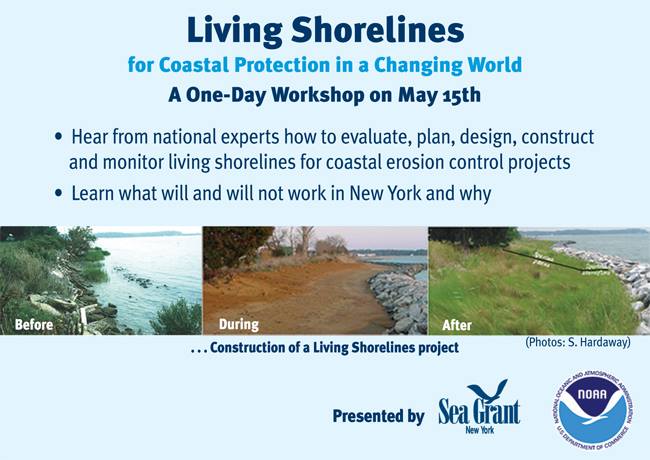Stony Brook, NY, October 7, 2013 - Climate change will exacerbate coastal flooding and erosion problems in many areas. Communities will be faced with increasingly difficult decisions about how to handle these threats. Retreat may become a more popular response in some areas, but protection may be needed in some highly developed shorelines, such as those found in New York.
To avoid adverse impacts associated with more traditional shore armoring techniques, such as bulkheads and revetments, the 2010 New York State Sea Level Rise Taskforce encouraged the use of “living shorelines” as a preferred method for erosion control in estuarine areas since this method has environmental benefits and was considered more “adaptable” to increased sea level rise. If living shorelines are to be used successfully as an adaptation measure to address coastal erosion impacts associated with climate change in New York, coastal decision makers and stakeholders must be more aware of this approach and better able to evaluate, plan and implement living shoreline projects.
In order to have coastal decision makers and stakeholders better prepared to respond and adapt to shoreline erosion impacts associated with climate change, NYSG Coastal Processes Specialist Jay Tanski established and convened a Living Shorelines Steering Committee/Working Group comprised of federal, state, and local government officials, coastal property owners and managers; marine contractors and consultants, and community leaders to help him compile, synthesize and distribute information and data on existing living shorelines with emphasis on potential New York applications.

In May 2013, Tanksi convened a “sold out” technical workshop on living shorelines for state and local officials, property owners and managers, marine consultants and contractors, and NGOs. Expert presenters from within and outside the Sea Grant network at the well-attended workshop gave specifics on topics such as siting and design criteria, costs and benefits, and discussed innovative living shorelines programs from the Gulf of Mexico, the southeast, and mid-Atlantic coasts. A concluding panel composed of agency and private sector representatives discussed what can work in New York. Tanski is now producing written and web-based materials as a separate but related project funded from other sources. More details presentations and YouTube clips from the event can be found via NYSG's related resources page, "Workshop: Living Shorelines for Coastal Erosion Protection in a Changing World."
In addition to the workshop report, a comprehensive digital compilation of existing technical material was produced and distributed to key stakeholders and used as the basis for written and Web based materials to be developed for New York audiences with funding obtained from other sources.